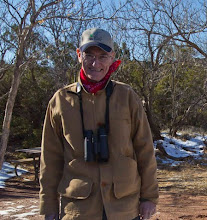Irv wrote: I found your article in the Houston Chronicle on leucistic birds very interesting and informative. We live in Conroe in Stewart’s Forest and fortunately still have lots of trees around us. We feed the birds black oiler sunflower seeds and have bird baths in our yard so we have a good variety of birds who visit our back yard. One of the birds is a cardinal with a white head. From the rest of the coloring I assume it is a female cardinal. You stated in your article that some birds with luecism have a hard time attracting a mate due to lack of their specific species color. I believe that this cardinal may have mated because on occasion I have seen one or two other cardinals with white plumage on their heads although their unusual coloring is not quite as obvious as the one we see more frequently.
My Answer: Well, apparently your leucistic female cardinal has beat the odds and attracted a mate. If she did mate, she would have passed on her defective genes and potentially produced the one or two other leucistic cardinals you've seen. Hard to know for sure without genetic analysis , so we can only guess. Be on the lookout for other leucistic species. If you see more birds with leucism other than the one or two cardinals, that could indicate some contaminate in their environment (it would not be in your sunflower seed.)
Friday, November 30, 2012
Thursday, November 29, 2012
December Travels to Texas
Tim wrote: I am a Florida birder and I am bringing the family to the San Antonio area for a 4 day stay in mid December. Might make a day trip to Corpus Christi.
We will be doing the usual tourist things as a family, but I can't resist to see if there are any potential lifebirds in the area. Do you have any leads on: Yellow Rail, Mountain Plover, Sage Thrasher, Sprague's Pipit, Harris's sparrow, or any of the 3 Longspurs? If I thought the chances were decent I would try to workin an outing or two to try and grab one or more.
Thanks in advance for any thoughts which you can share.
My answer: All the birds can be found in winter in Texas, but in most cases you'd have to drive hundreds of miles to different parts of the state and have a lot of luck on your side.
Yellow rails are in the coastal marshes, but nigh to impossible to see unless you trudge through a cottonmouth invested marsh. They don't normally call during winter.
Mountain Plovers can show up anywhere, but most likely in farm fields around Austin and west of Rockport.
Sage Thrashers are possible in the Hill Country north of San Antonio in the Kerr Wildlife Management Area west of Kerrville.
Sprague's Pipits are a sure thing at the Atwater Prairie Chicken NWR near Sealy, TX.
Harris's Sparrows tend to show up in hedgerows along farm field roads between Houston and San Antonio; the farm roads of the Katy Prairie west of Houston is a good place to look.
(Smith's Longspur found in eastern Harris County, Texas in 2011)
Longspurs are reliably found in the Texas Panhandle north of Amarillo and especially around Dalhart in the grassy fields of ranches---but you have to do a lot of driving around those roads to spot them. In fact, of all the birds you listed, the longspurs are the surest thing if you have the time and patience to look. It can also be brutally cold and windy in the Panhandle during winter.
We will be doing the usual tourist things as a family, but I can't resist to see if there are any potential lifebirds in the area. Do you have any leads on: Yellow Rail, Mountain Plover, Sage Thrasher, Sprague's Pipit, Harris's sparrow, or any of the 3 Longspurs? If I thought the chances were decent I would try to workin an outing or two to try and grab one or more.
Thanks in advance for any thoughts which you can share.
My answer: All the birds can be found in winter in Texas, but in most cases you'd have to drive hundreds of miles to different parts of the state and have a lot of luck on your side.
Yellow rails are in the coastal marshes, but nigh to impossible to see unless you trudge through a cottonmouth invested marsh. They don't normally call during winter.
Mountain Plovers can show up anywhere, but most likely in farm fields around Austin and west of Rockport.
Sage Thrashers are possible in the Hill Country north of San Antonio in the Kerr Wildlife Management Area west of Kerrville.
Sprague's Pipits are a sure thing at the Atwater Prairie Chicken NWR near Sealy, TX.
Harris's Sparrows tend to show up in hedgerows along farm field roads between Houston and San Antonio; the farm roads of the Katy Prairie west of Houston is a good place to look.
Longspurs are reliably found in the Texas Panhandle north of Amarillo and especially around Dalhart in the grassy fields of ranches---but you have to do a lot of driving around those roads to spot them. In fact, of all the birds you listed, the longspurs are the surest thing if you have the time and patience to look. It can also be brutally cold and windy in the Panhandle during winter.
Subscribe to:
Posts (Atom)

